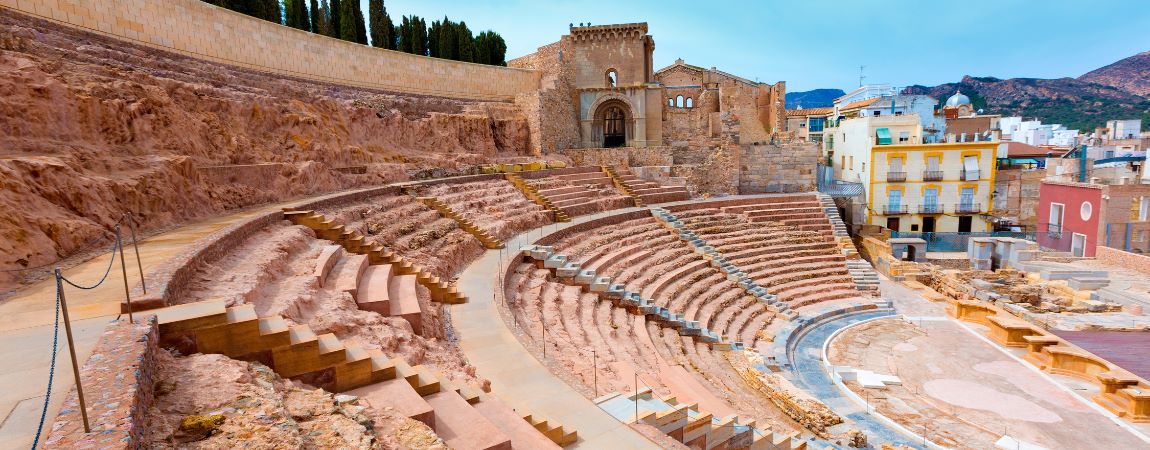The International Executive MBA is designed to solve the most critical challenges faced by leaders like you in a globalised and constantly changing business env
 Blog
BlogARCH Project preserves the legacy of the Roman Theater of Cartagena: A Cultural and Educational Commitment
The Roman Theater of Cartagena, with its imposing architecture and rich history, is set as the perfect backdrop for the ARCH Project.
The Roman Theater of Cartagena: A Cultural and Historical Treasure
In the heart of the historic city of Cartagena, in the Region of Murcia, lies a cultural treasure that transcends time: the famous Roman Theater of Cartagena. This imposing monument, a silent witness to the greatness of the Roman Empire, is not only a symbol of the region's rich history, but also an invaluable resource for education and culture.
The ARCH Project stands as a source of optimism in the mission to preserve and promote the cultural heritage of our region. Its goal, collaboration between organizations and institutions, opens the door to a future where students' digital and cultural competencies are enriched through the cultural heritage of each country.

The Importance of Preservation for Education and Culture
ENAE Business School is proud to be part of a consortium made up of eight institutions spread across four countries: Italy, Greece, Cyprus and Spain. This collaborative partnership includes the University of Peloponnese and Culturepolis from Greece; Wisefour from Cyprus; FUERM, Colegio Cruz de Piedra and Geinnova from Spain; and Istituto Comprensivo Melanzio Parini and Materahub from Italy. Each of these institutions contributes to making this consortium a benchmark in the promotion of educational innovation and cultural exchange.
The importance of preserving the Roman Theater of Cartagena goes beyond the mere conservation of a historical monument. This archaeological site is fundamental for young people, as its conservation is a piece of great relevance for academic training and understanding of art, architecture and Roman history.
Gamification as an innovative strategy to engage students
But how can we involve students in this noble effort of preservation and promotion? One innovative and effective way is through gamification. Through the use of educational games and interactive activities, we can spark students' interest in history and archaeology, while encouraging learning and participation.
The design of AR games would allow students to virtually explore the Roman Theater and discover both its hidden secrets and its intrahistory. On the other hand, organizing photography or drawing competitions on the monument allows students to express their creativity while learning about its history.
In addition, we could develop experiential learning activities, such as guided tours and archaeological workshops, that allow students to immerse themselves in the history and culture of the theater.

In conclusion, the Roman Theater of Cartagena is much more than a historical monument; it is a living treasure that holds the stories and dreams of past generations. By joining forces in the ARCH Project and leveraging gamification tools, we can ensure that this legacy lives on for generations to come, inspiring and educating the young minds of today and tomorrow.


Agri-food is a strategic sector for both the national and international economies.



A company or organization that anticipates, identifies needs and threats, foresees, and makes strategic and operational decisions based on Comprehensive Risk Management



In ENAE Business School's Official Master in Logistics and Operations Management program, you will learn how to analyse the performance of a company's operation

Business decision-making can no longer be based on intuition.


Master's Degree in Logistics in Spain: Key Factors for Choosing a Leading Program
Daniel Román Barker
Marketing Specialist at ENAE Business School, where he is part of the team responsible for planning, producing and optimising digital content for the enae.es and enae.com websites, as well as for the school's various social media channels. Using the Drupal CMS, he manages the publication and updating of pages and articles, ensuring brand consistency, content quality and user experience.
He specialises in SEO and performance marketing, defining and implementing the organic content strategy with the support of tools such as Sistrix and Google Search Console to improve positioning and qualified traffic to master's programmes and executive courses. In addition, he designs, configures, and optimises online advertising campaigns on Meta, LinkedIn, TikTok, and Google Ads, aligning segmentation, messaging, and objectives with student recruitment. His work contributes to ENAE's organic and paid growth and strengthens its position as a leading business school nationally and internationally.

Spanish companies hiring international talent: Your gateway is ENAE
Daniel Román Barker
Marketing Specialist at ENAE Business School, where he is part of the team responsible for planning, producing and optimising digital content for the enae.es and enae.com websites, as well as for the school's various social media channels. Using the Drupal CMS, he manages the publication and updating of pages and articles, ensuring brand consistency, content quality and user experience.
He specialises in SEO and performance marketing, defining and implementing the organic content strategy with the support of tools such as Sistrix and Google Search Console to improve positioning and qualified traffic to master's programmes and executive courses. In addition, he designs, configures, and optimises online advertising campaigns on Meta, LinkedIn, TikTok, and Google Ads, aligning segmentation, messaging, and objectives with student recruitment. His work contributes to ENAE's organic and paid growth and strengthens its position as a leading business school nationally and internationally.













